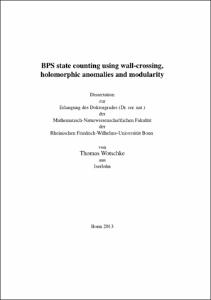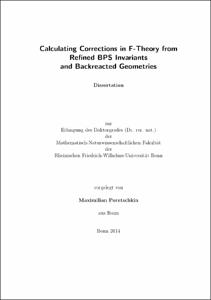Schimannek, Thorsten: Aspects of Fibers, Fibrations and their Non-Compact Limits in F-theory and Topological String Theory. - Bonn, 2018. - Dissertation, Rheinische Friedrich-Wilhelms-Universität Bonn.
Online-Ausgabe in bonndoc: https://nbn-resolving.org/urn:nbn:de:hbz:5n-51296
Online-Ausgabe in bonndoc: https://nbn-resolving.org/urn:nbn:de:hbz:5n-51296
@phdthesis{handle:20.500.11811/7595,
urn: https://nbn-resolving.org/urn:nbn:de:hbz:5n-51296,
author = {{Thorsten Schimannek}},
title = {Aspects of Fibers, Fibrations and their Non-Compact Limits in F-theory and Topological String Theory},
school = {Rheinische Friedrich-Wilhelms-Universität Bonn},
year = 2018,
month = jul,
note = {This thesis presents results about F-theory and topological string theory on genus one fibered Calabi-Yau manifolds and their non-compact limits.
In the first part we work in the fiber based approach to F-theory and study a conjectured relation between the global structure of the non-Abelian gauge group and discrete symmetries that are associated to mirror pairs of fibers. We provide a combinatorial explanation of this phenomenon for the class of hypersurfaces in two-dimensional toric ambient spaces. More generally, we formulate a toric criterion for Mordell-Weil torsion that applies to complete intersection fibers in higher codimension. We then check that the conjecture holds for the much larger class of codimension two complete intersections in three-dimensional toric ambient spaces. Finally we provide a detailed discussion of the geometry of a particular example. As a non-trivial consistency check we show that the non-Abelian anomalies in 6d compactifications are generically cancelled.
We then turn to the question of horizontal fluxes in elliptically fibered Calabi-Yau fourfolds. Determining properly quantized fluxes is an important problem in phenomenological applications of F-theory. We present a technique that uses the relation of topological brane charges under homological mirror symmetry to construct integral elements of the flux lattice. In many cases this leads to a complete basis. For the general class of non-singular elliptic fibrations we construct such a basis explicitly and use it to study the action of certain auto-equivalences of the category of B-branes on the charge lattice. We find that a particular set of auto-equivalences generates a projective action of the modular group and argue that this leads to an expansion of the topological string amplitudes in terms of quasi-modular forms. We then use the integral basis and numerical analytic continuation to perform a preliminary study of the flux vacua for a particular geometry.
In the last part of the thesis we study the non-compact limit of elliptic fibrations from the perspective of topological string theory. To this end we construct a compact embedding of C^3/Z_5 and describe the geometry in some detail. In particular we construct an integral basis of periods and use it to obtain a complete set of Picard-Fuchs operators. We can then identify the correct non-compact limit in the moduli space and determine the periods that remain finite. In this way we can relate the genus zero topological string amplitude on the non-compact geometry to the modular parameter of the mirror curve. We then use a theorem by Lockhart to derive a relation between the topological genus one amplitude and a particular product of theta functions. For mirror curves of genus two this leads to the fact that the propagator that appears in the holomorphic anomaly equations is an almost meromorphic Siegel modular form.},
url = {https://hdl.handle.net/20.500.11811/7595}
}
urn: https://nbn-resolving.org/urn:nbn:de:hbz:5n-51296,
author = {{Thorsten Schimannek}},
title = {Aspects of Fibers, Fibrations and their Non-Compact Limits in F-theory and Topological String Theory},
school = {Rheinische Friedrich-Wilhelms-Universität Bonn},
year = 2018,
month = jul,
note = {This thesis presents results about F-theory and topological string theory on genus one fibered Calabi-Yau manifolds and their non-compact limits.
In the first part we work in the fiber based approach to F-theory and study a conjectured relation between the global structure of the non-Abelian gauge group and discrete symmetries that are associated to mirror pairs of fibers. We provide a combinatorial explanation of this phenomenon for the class of hypersurfaces in two-dimensional toric ambient spaces. More generally, we formulate a toric criterion for Mordell-Weil torsion that applies to complete intersection fibers in higher codimension. We then check that the conjecture holds for the much larger class of codimension two complete intersections in three-dimensional toric ambient spaces. Finally we provide a detailed discussion of the geometry of a particular example. As a non-trivial consistency check we show that the non-Abelian anomalies in 6d compactifications are generically cancelled.
We then turn to the question of horizontal fluxes in elliptically fibered Calabi-Yau fourfolds. Determining properly quantized fluxes is an important problem in phenomenological applications of F-theory. We present a technique that uses the relation of topological brane charges under homological mirror symmetry to construct integral elements of the flux lattice. In many cases this leads to a complete basis. For the general class of non-singular elliptic fibrations we construct such a basis explicitly and use it to study the action of certain auto-equivalences of the category of B-branes on the charge lattice. We find that a particular set of auto-equivalences generates a projective action of the modular group and argue that this leads to an expansion of the topological string amplitudes in terms of quasi-modular forms. We then use the integral basis and numerical analytic continuation to perform a preliminary study of the flux vacua for a particular geometry.
In the last part of the thesis we study the non-compact limit of elliptic fibrations from the perspective of topological string theory. To this end we construct a compact embedding of C^3/Z_5 and describe the geometry in some detail. In particular we construct an integral basis of periods and use it to obtain a complete set of Picard-Fuchs operators. We can then identify the correct non-compact limit in the moduli space and determine the periods that remain finite. In this way we can relate the genus zero topological string amplitude on the non-compact geometry to the modular parameter of the mirror curve. We then use a theorem by Lockhart to derive a relation between the topological genus one amplitude and a particular product of theta functions. For mirror curves of genus two this leads to the fact that the propagator that appears in the holomorphic anomaly equations is an almost meromorphic Siegel modular form.},
url = {https://hdl.handle.net/20.500.11811/7595}
}









